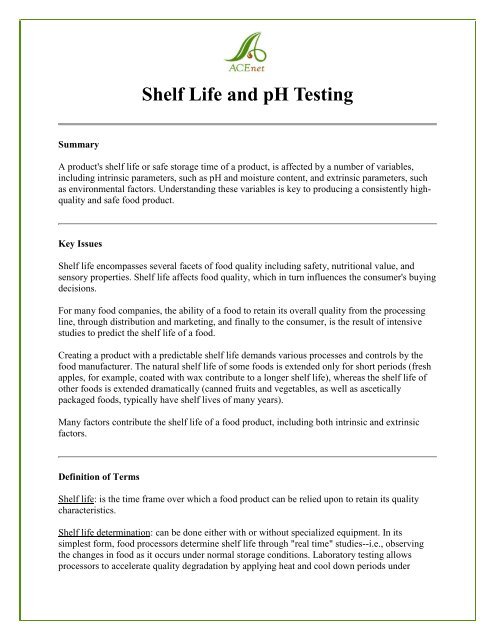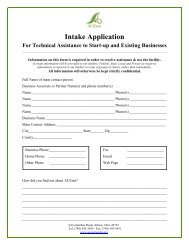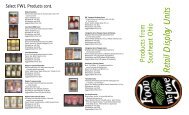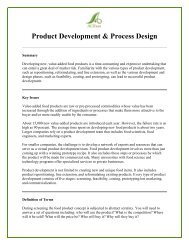Shelf Life and pH Testing - ACEnet
Shelf Life and pH Testing - ACEnet
Shelf Life and pH Testing - ACEnet
- No tags were found...
You also want an ePaper? Increase the reach of your titles
YUMPU automatically turns print PDFs into web optimized ePapers that Google loves.
<strong>Shelf</strong> <strong>Life</strong> <strong>and</strong> <strong>pH</strong> <strong>Testing</strong>SummaryA product's shelf life or safe storage time of a product, is affected by a number of variables,including intrinsic parameters, such as <strong>pH</strong> <strong>and</strong> moisture content, <strong>and</strong> extrinsic parameters, suchas environmental factors. Underst<strong>and</strong>ing these variables is key to producing a consistently highquality<strong>and</strong> safe food product.Key Issues<strong>Shelf</strong> life encompasses several facets of food quality including safety, nutritional value, <strong>and</strong>sensory properties. <strong>Shelf</strong> life affects food quality, which in turn influences the consumer's buyingdecisions.For many food companies, the ability of a food to retain its overall quality from the processingline, through distribution <strong>and</strong> marketing, <strong>and</strong> finally to the consumer, is the result of intensivestudies to predict the shelf life of a food.Creating a product with a predictable shelf life dem<strong>and</strong>s various processes <strong>and</strong> controls by thefood manufacturer. The natural shelf life of some foods is extended only for short periods (freshapples, for example, coated with wax contribute to a longer shelf life), whereas the shelf life ofother foods is extended dramatically (canned fruits <strong>and</strong> vegetables, as well as asceticallypackaged foods, typically have shelf lives of many years).Many factors contribute the shelf life of a food product, including both intrinsic <strong>and</strong> extrinsicfactors.Definition of Terms<strong>Shelf</strong> life: is the time frame over which a food product can be relied upon to retain its qualitycharacteristics.<strong>Shelf</strong> life determination: can be done either with or without specialized equipment. In itssimplest form, food processors determine shelf life through "real time" studies--i.e., observingthe changes in food as it occurs under normal storage conditions. Laboratory testing allowsprocessors to accelerate quality degradation by applying heat <strong>and</strong> cool down periods under
carefully monitored conditions. <strong>Shelf</strong> life determination that might take months or years todetermine under "normal" conditions, might take only weeks or months under lab conditions.Intrinsic parameters: are those factors that are an integral part of a foods physical makeup,including water activity, <strong>pH</strong>, moisture content, <strong>and</strong> anti-microbial agents. Canned tomatoes, forinstance, which have a low <strong>pH</strong> (<strong>and</strong> are considered highly acid), have natural properites thatcontribute to a long shelf life.Extrinsic parameters: are those factors that can be controlled or changed to influence a product'sshelf life, including temperature, time, relative humidity, presence of gases, <strong>and</strong> otherenvironmental factors. Vacuum packaged foods, for example, depend upon the absence ofoxygen to extend the shelf life of many fresh <strong>and</strong> processed food.<strong>pH</strong> control: is a common method used to extend the shelf life of products. PH is a scaled measureof the acidity or alkalinity of a food: the lower the <strong>pH</strong>, the higher the acidity. Most bacteria thatcontribute to food spoilage do not prosper in acidic conditions. Pickled foods, for example, aremade shelf stable by the addition of some type of acidifying agent, such as lemon juice orvinegar.Water activity: refers to the amount of unbound or "free" water in a system available to supportbiological <strong>and</strong> chemical reactions. Generally speaking, the lower the water activity, the lessviable are those microorganisms that contribute to food spoilage. Peanut butter, which has a longshelf life under non-refrigerated conditions, is a common food that has low levels of "available"water.Preservatives: belong to a class of food additives that extend shelf life by inhibiting microbialgrowth, or by minimizing the destructive effects of oxygen, metals, <strong>and</strong> other factors that maylead to rancidity. Common preservatives include nitrites (used extensively in processed meats),sodium benzoate (often added to soft drinks), sorbic acid (dairy products), calcium <strong>and</strong> sodiumpropionates <strong>and</strong> sorbates (mold inhibitors used in baked goods), <strong>and</strong> common table salt.Print ResourcesReference Guide for Kansas Food Processors: Call 785-296-3737 to order.Starting a Shared Use Kitchen Incubator (available through the National Business IncubatorAssociation's bookstore. Visit their web page at www.nbia.org)Kansas State Resource Guide Call 785-296-37373 to order.







